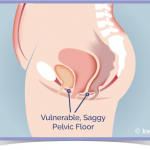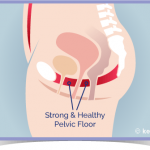Suffering with a LEAKY TAP?
Panty liners and a pair of clean knickers. Not quite the items you’d imagine you’d find in your handbag 20 years ago, but here you are, crossing your legs tightly as you queue for the next available toilet cubicle. And you don’t quite know how much longer you can last…
1 in 3 women suffer from urinary incontinence.
It’s a subject that is rarely discussed in public, yet most women are aware of it and accept their fate of suffering from leaks. But is incontinence inevitable?
What is incontinence ?
Incontinence is defined as the involuntary release of urine or faecal matter. There are numerous forms of incontinence. Some may be more familiar to you than others, and some you may not have even considered a problem.
•Do you find yourself leaking a little when you’re giggling with the girls? That’s Stress Incontinence.
•Do you feel the need to go to the toilet the second you get home? That’s Latch Key Syndrome.
•Do you sometimes get sudden urges to go to the toilet? That’s Urge Incontinence.
•Do you leak a little during intercourse or masturbation? That’s Coital Incontinence.
Essentially, whether you’ve got a leaky tap or a burst pipe – it’s incontinence and it is preventable.
Who suffers from incontinence?
The word incontinence often gets us thinking of little old ladies in care homes who leak whenever they cough or laugh. Although somewhat true, incontinence doesn’t just affect the elderly. In fact, leaking urine can be influenced by the strength of a person’s pelvic floor.
The pelvic floor is a hammock-shaped group of muscles that supports all your pelvic organs, including your bladder and bowel.
If the pelvic floor muscles are strong, you’ll find it easy to control your bladder and bowel. If they are weakened, you may find yourself leaking a little here and there. Throughout life, these muscles can naturally deteriorate. That’s why it’s so important to learn how to improve and maintain the strength of your pelvic floor.


STRESS INCONTINENCE is very common amongst mothers.
This is where you find yourself leaking when laughing, coughing, lifting or doing anything that puts extra pressure on your pelvic floor. Unfortunately, most mums think that leaking is just part of the package of motherhood, but this is not the case! Incontinence is common, but it is not normal! 45% of mothers still suffer from urinary incontinence 7 years after giving birth. And, those who suffered from urinary incontinence after childbirth are likely to still be incontinent 12 years later! Yet it is not necessary.
Incontinence is easily prevented and even reversible!
MENOPAUSE
You may also find yourself experiencing bladder leakage as you approach the menopause. During the menopause, your oestrogen and collagen levels plummet. Collagen is the vital protein that keeps the pelvic floor strong and supportive and, without it, the muscles become weak and may not function as they used to. Weakening of the muscles can lead to a loss of control of the bladder or even a pelvic organ prolapse! 50% of women over 50 will experience some form of pelvic organ prolapse, and these chances increase if you undergo a hysterectomy. The good news is that you can easily improve and maintain the strength of your pelvic floor!
How to treat incontinence
Recognising the importance of the pelvic floor before any signs of weakness is the best possible circumstance. Your pelvic floor muscles are really pushed to their limits during pregnancy and the menopause, so strengthening your muscles beforehand can really give you the upper hand.
The easiest way to strengthen those vital muscles is by performing Kegel exercises.
A Kegel (pelvic floor exercise) is a contraction of your pelvic floor muscles. Just like any other muscle, your pelvic floor muscles need a workout too, to help them stay strong and supportive.
To perform a Kegel, follow these steps:
1.Squeeze your anus as if you’re trying to hold in wind.
2.Tighten the muscles around your vagina.
3.Squeeze both areas and lift them upwards towards your navel.
4.Make sure you’re not pushing downwards as this can damage the muscles.
5.Perform 10 fast (2 second) Kegels and 10 slow (10 second) Kegels 3 times per day.
Already suffering from bladder leaks? You don’t have to tolerate it! Kegels can also help you to regain strength and control of your bladder and/or bowel, so it’s never too late to start practicing
your Kegel exercises as they’ll help you :
•Re-tone your pelvic floor
•Control your bladder and bowel movements
•Prevent pelvic organ prolapse
•Improve intimate sensations
It’s best to begin with gentle, short pelvic floor squeezes that you can gradually build upon. If you’re struggling to tell whether you’re doing your Kegels correctly, don’t worry, you wouldn’t be the only one – nearly 50% of women don’t know how to perform a pelvic floor contraction correctly.
You can always try a gadget that can help you to engage your pelvic floor muscles too!
Whether you are currently suffering from little leaks or not, it’s important that you recognise the importance of the pelvic floor muscles in controlling bladder and bowel functions. Motherhood and menopause do not have to involve a mountain of sanitary pads to keep you dry. As normal as the ‘sensitive bladder’ adverts make it seem, incontinence is far from normal and you do not have to suffer.
Take control of your bladder health today.
For further information and products to help with your bladder health visit www.kegel8.co.uk/mamalife
Kegel8 are also offering £20.00 off your purchase of a KEGEL8 ULTRA 20 ELECTRONIC TONER. Enter MAMALIFE at checkout.










